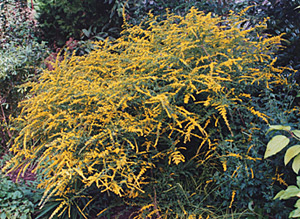
Something to sneeze at — Giant ragweed and its cousin the common ragweed are chief contributors to hay fever this time of years. Photo courtesy University of Texas
Poor goldenrod can’t get any respect.
At the first achoo, this native plant gets blamed for the sneezing, coughing and itchy eyes of hay fever. In fact, the rap on the garden-worthy goldenrod is so serious that some plant tags proclaim the perennial does not cause hay fever.
The major hay fever culprit is ragweed, another native that blooms in late summer and into fall about the same time as goldenrod, but does not have any garden worthiness.
Two ragweeds are prolific in Indiana. The common ragweed (Ambrosia artemisiifolia) is an annual that gets 1 to 4 feet tall and can be found growing anywhere. The one that’s hard to miss is the 12- to 18-foot, giant ragweed (A. trifida), a perennial that grows along bottomlands, roadsides and other places where the soil has been disturbed, even our landscapes.
Ragweeds’ flowers are not particularly showy. With the Latin name Ambrosia, you’d think ragweed would have better attributes than hay fever.
The attributes of goldenrod (Solidago) are its flowers, which add beautiful color in Mother Nature’s late summer landscape, giving these perennials their common name. There are 100 species of goldenrod, mostly in eastern North America. Their golden yellow sprays are easy to identify along roadsides, where goldenrod grows with other native plants – purple ironweed (Vernonia) and blue Aster.
Like a lot of North American native plants, goldenrods have been the rage among European and English gardeners for years. Interest in this species from Americans has picked up the last 10 years.

Garden worthy — ‘Fireworks’ goldenrod sparks up the late summer landscape. © Jo Ellen Meyers Sharp
Gardeners have several hybrid cultivars of goldenrod for fall color in our landscapes. Most goldenrods are hardy throughout Indiana, where they attract butterflies, hummingbirds and other pollinating wildlife. They do best in full sun and with average, moist soil. However, they tolerate dry soil and once established, are fairly drought tolerant. Goldenrods make terrific cut flowers, too. Here’s a sampler:
- Fireworks (S. rugosa) gets 3 feet tall and wide, making it a perfect size for most gardens. This cultivar does not seem to be bothered by powdery mildew, a fungus that certain goldenrods may get.
- Golden Fleece (S. sphcelata) gets up to 14 inches tall and 24 inches wide. This low growing perennial has arching stems loaded with yellow flowers.
- Dansolitlem, marketed as Little Lemon, gets up to 12 inches tall and 18 inches wide, depending on the location. Densely packed panicles of lemon yellow flowers cover the plant.
Goldenrods make good companions with asters, butterfly bush (Buddleja), Russian sage (Perovskia) or ornamental grasses.